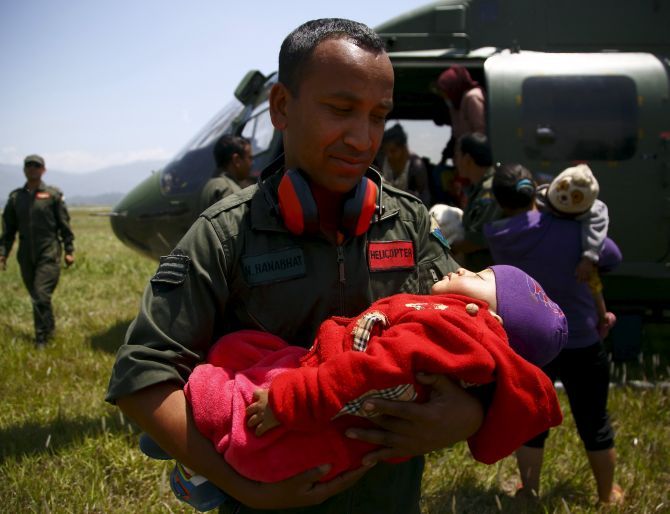Lifting the gloom on a day marred by more aftershocks that kept people in Nepal on edge and a rising death toll that topped the 7,000-mark, rescuers on Sunday pulled out three more survivors from under the debris of their homes who were miraculously alive eight days after the quake.
Fresh aftershocks, including one measuring 4.3 on the Richter Scale, sent a new wave of panic among people, most of whom have been staying in the open battling bad weather and scarce food and water supplies following the country’s worst earthquake in 80 years.

At least 7,056 people have been confirmed dead from the 7.9-magnitude April 25 quake while the number of injured has risen to 14,227, with Finance Minister Ram Sharan Mahat saying the death toll is expected to climb “much higher”.
“The aftershocks have not receded, and we expect the final casualty numbers to climb much higher,” said Mahat, portraying a desperately bleak situation in his comments at an event on the sidelines of an Asian Development Bank meeting in Baku.
“It is with great pain and sadness that I stand before you to present the case of my country Nepal which now remains devastated,” he said, adding that the quake had caused “incalculable human loss and suffering, with millions of people rendered homeless”.
Officials said an entire village was carried away by the avalanche and many more people are believed to have died.
Meanwhile, hopes of finding more survivors were rekindled as rescuers pulled out two men and a woman alive from under mounds of debris, eight days after the devastating quake struck the Himalayan nation and three days after a teenage boy and a woman were saved.
They were found near the mountainous Syauli village and have been taken to a nearby military hospital for treatment.

Nepal had said chances of finding survivors buried in the rubble are “extremely slim”, with home ministry spokesman Laxmi Dhakal saying “it will be a miracle if anyone is found alive” though he denied that administration has given up yet and that rescue teams were continuing to look.
At least 38 Indians are among 54 foreigners killed in the quake that left a trail of devastation and suffering, flattening buildings and uprooting electric poles and trees.
Police said 48 foreigners, including 10 Indians, were injured and 82 foreign nationals missing. Separately, as many as 51 bodies, including of six foreigners, in the popular Langtang trekking region have been pulled out by police, a report said and quoted an official that about 100 foreigners might still be missing in the area.
Twelve stranded trekkers, including an Indian national, were rescued on Sunday from Makalu Base Camp in eastern Nepal and flown to Kathmandu.
Nepal parties have agreed that all those interested in carrying out relief work in the country can start at once, without having to route the process through the government.

A report released by the United Nation’s humanitarian agency Office for the Coordination of Humanitarian Affairs said the number of houses destroyed in the country is over 1,60,000, nearly twice the number of households wrecked in the 1934’s deadly temblor that has been the country’s worst disaster of all times.
The UN urged Nepal to relax customs controls, which it says are holding up deliveries of aid coming from countries around the world from reaching the survivors.
Nepal had a duty to provide faster customs clearance for relief supplies, said UN humanitarian chief Valerie Amos, who along with the European Union’s Commissioner for Humanitarian Aid and Crisis Management, Christos Stylianides called on Prime Minister Sushil Koirala and reaffirmed the commitment of the international community to support the country.
“A disaster of such magnitude would test the capacities of any government in the world,” said Stylianides.

Nepal army forces in collaboration with members of an American Search and Rescue team search for survivors in the rubble after the Nepal quake. Photograph: Omar Havana/Getty Images
The country’s only main airport the Tribhuvan International Airport has been closed for large aircraft due to runway damage that forced authorities to take such a step in the middle of the calamity.
The runway was built to handle only medium-size jetliners, not the large military and cargo planes that have been flying emergency supplies to Nepal, said manager of the airport Birendra Shrestha.
Domestic and international emergency response teams are racing against time and odds to rush in medical aid to people in worst-affected areas of the quake-hit country, including through flying in mobile clinics to far-flung villages and providing in psychological support to traumatised victims of the tragedy.





